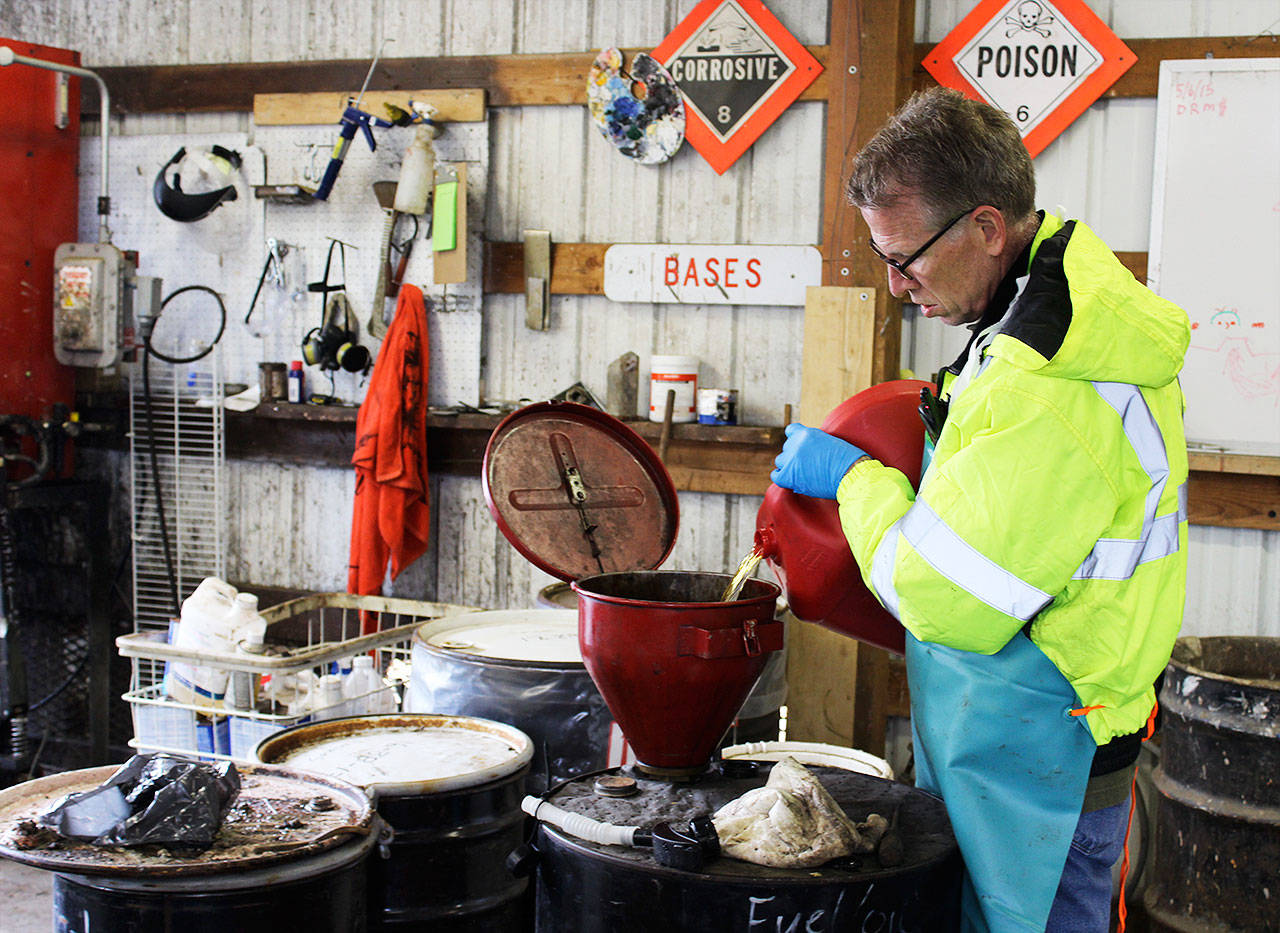Gene Clark’s job is toxic.
And he prefers it stay that way.
But looming cuts in the Washington state budget may affect the Island County program he oversees that collects and disposes of everyday items that are useful but dangerous to people and the environment.
Weed killer, oven cleaner, oil-based paint, motor oil, that old can of nasty rusting in your shed.
Last year, Island County collected 297,000 pounds of household hazardous waste. Motor oil accounted for 195,000 pounds; none of that came from auto shops, “just a lot of do-it-yourself oil changes,” Clark said.
Funded by a state program called Coordinated Prevention Grants, the hazardous waste collection is targeted as one of many areas to cut in order to boost education. It’s managed by the Washington Department of Ecology as an incentive to reduce exposure to toxins.
“The funds that have paid for this program are being threatened,” Clark said, pointing to rows and rows of barrels identified with labels such as acids, poisons, aerosols, oxidizers, paints.
In short, all items marked with a skull and crossbones symbolizing death, danger, and dispose of properly should end up at the Coupeville Solid Waste Facility. Here, they’re categorized, condensed, sealed and loaded into 55-gallon black drums bound for processing plants across the country.
“You don’t want the risk of mixing any of this into (regular) trash,” explains Clark, recycle and hazardous waste coordinator. “You run the risk of spontaneous combustion.”
Four years ago, $28 million was allocated to counties for Coordinated Prevention Grants. Two years ago, that amount was reduced to $15 million. In the current proposed capital budget still undergoing revisions in a legislative Special Session, $10 million is allocated in both the governor’s and senate budgets.
“The state Legislature has been reducing the funding for this service for a number of years,” said County Commissioner Helen Price Johnson. “Locally, that means a reduction in capacity from $92,000 annually to approximately $20,000 within our Environmental Health department.”
Three solid waste employee salaries are partially funded and one position is entirely paid for with the prevention grants, said Joantha Guthrie, Island County Solid Waste Manager.
“We’re looking at possibly having to do away with one position. We really don’t know at this point,” Guthrie said. “But it’s not looking good.
“I’m really hoping there won’t by an impact to the public but we just don’t know.”
Charging a fee to dispose of hazardous household items could be one of many options but that would defeat the program’s ultimate goal.
“We need to keep the toxins and hazardous material out of the general waste stream and that’s what this free program does,” Clark said. “We get so much oil-based paint turned in. If people had to start paying, people would be dumping it wherever, which is what used to happen.”
Last year, 42,000 pounds of oil-based paint were processed at the Coupeville facility. (It does not accept water or latex-based paint because that can be solidified and thrown in regular trash.)
“Without adequate state funding, mismanaged properties will be left to pollute the environment and costs will go up with more emergency clean up,” Price Johnson said. Without the transfer station collection program, she predicted “many hazardous materials will be dumped on private property.”
Monday, Freeland residents Bob Brower and Debra Whitson pulled into the Coupeville household hazardous waste area to get rid of gasoline that had been sitting on an idle boat. They unloaded a few 5-gallon portable gas cans and said they’d be returning with more.
“It has a 90-gallon tank and it’s almost full,” Brower said of the fishing boat. “We just bought it and needed to drain the tank.”
Added Whitson: “It was probably $1.10 a gallon when that gas was put in there.”
John Vance, a solid waste technician trained in hazardous materials, poured the gasoline into a big drum before being paged to check on a refrigerator coming in to be dumped; refrigerators have to be drained of solvents.
Last year, more than 5,300 residents took advantage of the household hazardous waste disposal sites, bringing in 6,000 pounds of aerosol cans and thousands upon thousands of bottles, cans and crates of seriously deadly chemicals.
Clark holds up a can of aluminum phosphide, which can turn into a deadly gas called phosphine gas when mixed with water.
“This is the same stuff that killed that family of four in Texas around Christmas,” he explains. “ They used it as a pesticide to get rid of mice under their mobile home, it got wet and the fumes killed them.”
Weird, wacky and wild things also end up here.
Snakes, worms, a dog fish, and an “alien” reside in the corner. They’re bottled in jars of formaldehyde and kept as a treasure trove of tacky trash. Except for the really bizarre plastic alien doll, it’s all real.
And sometimes stuff isn’t poisonous but just plain peculiar.
“Just this morning, someone left me all the fixins’ for a pina colada except for the rum,” Clark laughed. “Shredded coconut, coconut milk and a bottle of Southern Comfort.
“It’s kind of like a box of chocolates,” he mused. “You just never know what you’ll get.”



